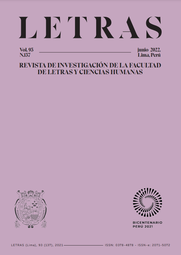The faces of holiness. Jesuit martyrs and founders on the tiles of the sacristy of “San Pedro de Lima”
Abstract
This article seeks to determine the origin of the artistic sources that would have served as inspiration for the realization of the portraits of the holy martyrs and Jesuit founders reflected in the medallions or cartouches on the tiles of the sacristy of the old Colegio Máximo de San Pablo (currently San Pedro de Lima). Although there are studies that have established European engravings as a source of viceroyalty painting in Lima from the 17th and 18th centuries, no study has been carried out in relation to the origin of the images of the aforementioned sacristy. Likewise, it is intended to specify that the meaning of the characters in the tile medallions would represent an ideal of life for the Jesuit, as well as a reminder of the sacrifices that must be made to fulfill the evangelizing ideal of the order. With this repertoire of its own saints, the nascent Jesuit order affirmed itself with its own saints in relation to other religious orders. Additionally, the analysis of the images of the saints represented on the tiles will contribute to hagiographic studies of the Society of Jesus, since San Pedro de Lima contains the most extensive Jesuit collection of these images in South America.Downloads
Métricas alternativas
References
Bailey, G. (2019). Una orden misionera sin santos: jesuitas no beatificados y no canonizados y santidad sustituta en Italia y Perú. Material de Mesas de Osma II. Conferencias Magistrales sobre Arte virreinal. Museo Pedro de Osma, Proyecto de Estudios Indianos del Departamento Académico de Humanidades de la Universidad del Pacífico y Biblioteca Nacional del Perú.
Cordero, A. (2011). La Virgen de Guadalupe y los santos de la Compañía. Anales del Instituto de Investigaciones Estéticas, 38(99), 253-271. https://doi.org/10.22201/iie.18703062e.2011.99.2392
Gámez, J. (2014). Francisco de Zurbarán y la Compañía de Jesús: la visión de San Alonso Rodríguez. Santidad, plástica y reforma. En F. Lorenzana de la Puente y R. Segovia Sopo (Coords.), XV Jornadas de Historia de Fuente de Cantos Zurbarán, 350 Aniversario de su muerte (1598-1664) (pp. 149-166). Asociación Cultural Lucerna, Sociedad Extremeña de Historia.
García, R. (2020). El retablo de San Estanislao de Kostka en San Luis de los franceses de Sevilla. Archivo español de arte, 93(371), 239-258. https://doi.org/10.3989/aearte.2020.16
Méndez, L. (2006). Festejos por la canonización de los mártires del Japón. Carmona, escena de los jesuitas. Laboratorio de Arte, 19, 483-494. http://institucional.us.es/revistas/arte/19/026%20mendez.pdf
Michaud, C. y Torres, J. (Eds.). (2009). De Amberes al Cusco. El grabado europeo como fuente del arte virreinal. Centro Cultural Pontificia Universidad Católica del Perú.
Muñiz, Á. (2015). La ilustración del libro como generador de modelos. Pintores Canarios del barroco y su relación con el grabado. Anuario de Estudios Atlánticos, 61, 1-19. http://anuariosatlanticos.casadecolon.com/index.php/aea/article/view/9315
Ortega, E. (2016). El martirio y el triunfo de los jesuitas en Nagasaki: la iconografía y sus fuentes en los colegios jesuíticos del País Vasco y Navarra. Revista de Arte, 36,121-141.
Osswald, C. (2009). A Iconografia do Martírio na Companhia de Jesus entre os Sécs. xvi e xviii. Revista Portuguesa de Filosofia, 65, 1301-1313.
Page, C. (2019). Los primeros retratos de Ignacio y los inicios de la iconografía ignaciana. IHS. Antiguos jesuitas en Iberoamérica, 7(2), 63-75. https://doi.org/10.31057/2314.3908.v7.n2.27671
Ramírez, L. (1999). Azulejos y evangelización en Lima colonial. Historia y Cultura, 23, 177-215.
Ramírez, L. (2002). Juan del Corral y la azulejería limeña del siglo XVII. (Tesis para optar el título de Licenciado en Historia del Arte), Universidad Nacional Mayor de San Marcos, Facultad de Letras y Ciencias Humanas.
Rodríguez G. de Ceballos, A. (2002). El mártir, héroe cristiano. Los nuevos mártires y la representación del martirio en Roma y en España en los siglos XVI y XVII. Quintana, 1, 83-99. https://minerva.usc.es/xmlui/handle/10347/6287.
Tylenda, J. (1998). Jesuit saints and martyrs. Short biographies of the Saints Blessed, Venerables, and Servants of God of the Society of Jesus. Loyola Press.
Vargas Ugarte, R. (1963). Los jesuitas del Perú y el arte. s/e.
Vlam, G. (1979). The portrait of S. Francis Xavier in Kobe. Zeitschrift für Kunstgeschichte, 42(1), 48-60. https://doi.org/10.2307/1482014
Wuffarden, L. (2019). La pintura y los programas iconográficos. San Pedro de Lima. Iglesia del antiguo Colegio Máximo de San Pablo (pp. 205-268). Banco de Crédito del Perú.
Copyright (c) 2022 Letras (Lima)

This work is licensed under a Creative Commons Attribution 4.0 International License.
Este obra está bajo una licencia de Creative Commons Reconocimiento 4.0 Internacional



















